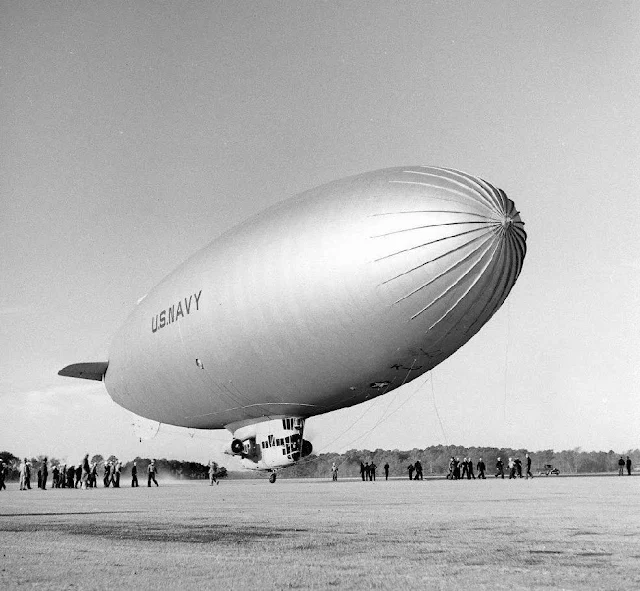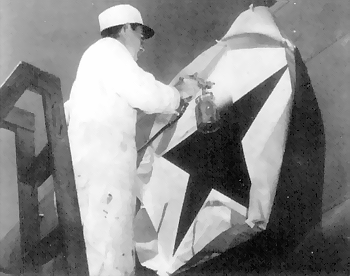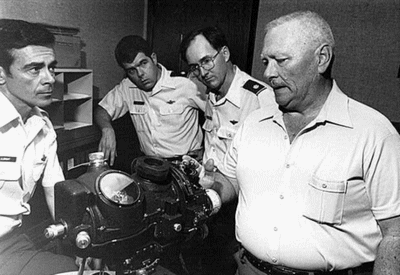 |
| Grumman F4F Wildcat of VF-6 testing out machine guns aboard USS Enterprise, 10 April 1942. |
 |
| Ensign Darrell Bennett stood beside his Grumman FM-2 Wildcat 'Smokey's Lucky Witch', USS Gambier Bay, 1 August 1944 |
 |
| A Grumman F6F Hellcat carrier-based fighter aircraft of VF-12 on the flight deck of USS Saratoga (CV-3) in November 1943. |
 |
| F6F-5, 23, flown by Ens. Ardon R. Ives crash lands on the USS Lexington, February 1945 (Ives survived the crash but died in a dogfight in May 1945). |
 |
| VMF(N)-533 F6F Hellcat night fighters seen from an R5C guide plane on the way from Engebi to Saipan. |
 |
| Bell YFM-1A Airacuda. |
 |
| Ryan FR-1 Fireball. |
 |
| Ryan FR-1 Fireball. |
 |
| Beech GB-2 Traveler. |
 |
| C-47 Skytrain crash landed after dropping supplies to Bastogne, Belgium, December 1944. |
 |
| Douglas C-54 Skymaster under construction. |
 |
| Noorduyn YC-64 Norseman IV (42-5046), probably at the U.S. Air Force Museum at Wright-Patterson AFB, Ohio. |
 |
| Noorduyn YC-64 Norseman IV (42-5046), probably at the U.S. Air Force Museum at Wright-Patterson AFB, Ohio. |
 |
| Noorduyn UC-64 Norseman, interior set up for two stretcher cases, January 15, 1944. |
 |
| Curtiss C-46 Commando. |
 |
| Curtiss C-46 Commando with Curtiss P-40 in background. |
 |
| Curtiss C-46 Commando (42-101211). |
 |
| Curtiss C-46 Commando. |
 |
| Japanese "giretsu" commando killed on runway of Yontan Airfield. Destroyed C-46 Commando in background. |
 |
| A Goodyear dirigible of the M Class, which had a helium capacity of 725,000 cubic feet. |
 |
| K Class patrol airship. |
 |
| K Class patrol airship gondola. |
 |
| K Class patrol airship gondola during landing. |
 |
| WAVES on a K-2 Class airship. |
 |
| US Navy K-class airships of Airship Patrol Squadron ZP-11 and several TBM Avengers in hurricane storage at NAS South Weymouth, Massachusetts, 14 September 1944. |
 |
| Bristol Beaufighter, USAAF. |
 |
| Barrage balloon at Parris Island, South Carolina. May 1942. |
 |
| The U.S. Army Air Corps’ 1st Balloon Squadron prepares to launch one of the first World War II barrage balloons at Fort Sill, Oklahoma, 4 April 1941. |
 |
| Barrage balloon, USMC. |
 |
| B-29 Superfortress (41-38880 in foreground). |
 |
| B-29 Superfortress of the 499th Bomb Group over Mount Fuji, 1945. |
 |
| Boeing B-29 Superfortress. |
 |
| Boeing B-29 Superfortresses. |
 |
| Boeing B-29 Superfortress 44-87775. |
 |
| Boeing B-29 Superfortress. |
 |
| Boeing B-29 Superfortress landing. P-51 in foreground. |
 |
| Boeing B-29 Superfortress. |
 |
| Chinese workers building runway for B-29s. |
 |
| Martin B-26 Marauder (41-31669). |
 |
| Martin B-26B Marauder (41-17876) USAAF. |
 |
| Martin B-26 Marauder. |
 |
| Martin B-26 Marauder (41-17747). |
 |
| AT-21: Fairchild advertisement. |
 |
| Surplus B-25 Mitchell and B-26 Marauder bombers stored at Cal Aero Field, Chino, California. Other aircraft visible in the distance. |
 |
| R2800 engines at the factory awaiting shipment. |
 |
| Torpedo Five’s attack on Jaluit airdrome. |
 |
| Before light comes, seven bright fires burn on Marcus airstrip after American aerial attack. |
 |
| The seven fires, from seven planes strafed and set afire by Commander Crommelin, still smoke. Marcus is burning elsewhere, too. |
 |
| In the afternoon five of the seven Japanese torpedo planes are burned out. Below, to the left, a bomb explodes on the airstrip. |
 |
| Henderson Field, Guadalcanal, seen from the air. |
 |
| Aerial view of the Segi airstrip built by Bill Painter, finished on time. Photographed in July 1943 by a U.S. bomber returning from a raid on Munda. |
 |
| View of Naval Air Station Ford Island, Oahu, US Territory of Hawaii, 8 December 1941; note OS2U, SOC, PBY-5, F4F-3, and TBD-1 aircraft. |
 |
| Two soldiers sit on the wreckage of a bomber, surrounded by dirt and sandbags, on Hickam Field after the Japanese attack, December 7, 1941. |
 |
| A sailor runs for cover past flaming wreckage hit by dive bombers, Kaneohe Bay Naval Station, Pearl Harbor, Hawaii, December 7, 1941. |
 |
| Aboard USS Lexington (CV-16) an LSO guides a pilot in with the paddles. |
 |
| Eighth Air Force, UK, 1942. |
 |
| Aerial view of Naval Air Station Ford Island, Oahu, US Territory of Hawaii, 10 December 1941; note damaged PBY aircraft, USS Curtiss, and USS Shaw. |
 |
| Painting the U.S. star on a factory-fresh plane. |
 |
| Atlantic kit: Gold ring and coins used by aircrews as barter when shot down. |























No comments:
Post a Comment